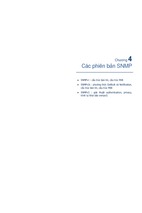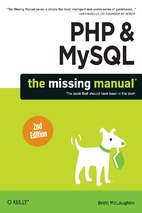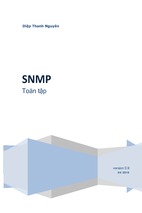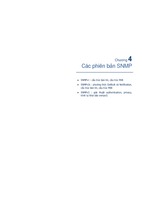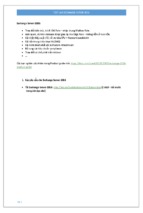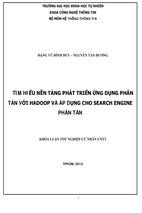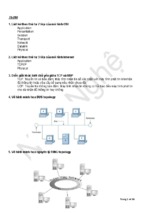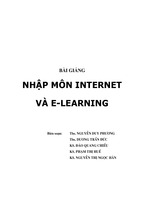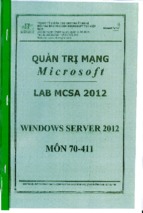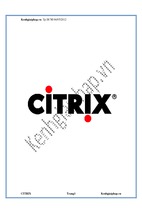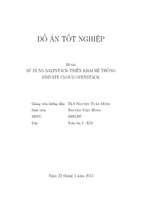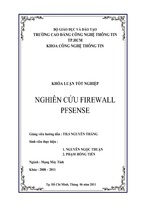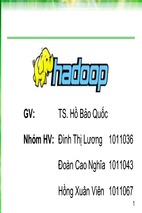8/25/2014
Module 4: Cloud Computing &
SaaS
Overview
•
•
•
•
•
•
•
Whatt iis cloud
Wh
l d computing?
ti ?
Business advantages
Architecture
Issues and challenges
SaaS
Utility Computing
Grid computing
1
8/25/2014
Definitions
• “The rise of the cloud is more than just another platform shift that
gets geeks excited. It will undoubtedly transform the IT industry, but
it will also profoundly change the way people work and companies
operate.” - The Economist, “Let it Rise,” 10/23/08 (Sun Cloud
Computing 2009)
• “A pool of highly scalable, abstracted infrastructure, capable of
hosting end-customer applications, that is billed by consumption”(Staten 2008, Forrester Research)
• “Cloud computing is the set of disciplines, technologies, and
business models used to render IT capabilities as on-demand
services” (www.burtongroup.com)
• “Cloud Computing is the sum of SaaS and Utility Computing”
(Armbrustet al. 2009)
Definitions (con)
• “It’s one of the foundations of the next generation of computing. . ..
It’s a world where the network is the platform for all computing,
where everything we think of as a computer today is just a device
that connects to the big computer we’re building. Cloud computing is
a great way to think about how we’ll deliver computing services in
the future.” —Tim O’Reilly, CEO, O’Reilly Media (Sun Cloud
Computing 2009)
• “A Cloud is a type of parallel and distributed system consisting of a
collection of interconnected and virtualised computers that are
dynamically provisioned and presented as one or more unified
computing resources based on service-level agreements
established through negotiation between the service provider and
consumers” (Buyyaet al. 2008)
• “Clouds are clearly next-generation data centerswith nodes
“virtualized” through hypervisor technologies such as VMs,
dynamically “provisioned” on demand as a personalized resource
collection to meet a specific service-level agreement, which is
established through a “negotiation” and accessible as a composable
service via “Web 2.0” technologies»(Buyyaet al. 2008)
2
8/25/2014
What is Cloud Computing?
• New computing paradigms have been proposed and
adopted, with the emergence of technological
advances
d
such
h as cluster
l t computing,
ti
G
Grid
id computing,
ti
P2P computing, service computing, market-oriented
computing, and most recently Cloud computing(Buyyaet al. 2008)
• “Clouds provide on demand resources or services
over the Internet, usually at the scale and with the
reliability of a data center” (Grossman 2008)
• You
Y use what
h t you need
d and
d you pay ffor what
h t you use
e.g. Amazon S3 and Simple DB and Google App
Engine all charge based on storage, bandwidth, and
CPU time services run on shared infrastructure
Cloud Computing
“Cloud computing gives an edge to enterprises
as they can add capabilities and increase
capacities on the fly without having to invest in
infrastructure, training or licenses. One of the
most important features of cloud computing is
automated management and reallocation of
resources. This means that a user can work on
a platform without worrying about adaptability,
scalability and elasticity.”
Kaustubh Dhavse
Deputy Director of ICT practice at Frost & Sullivan
3
8/25/2014
Cloud Computing –3.19 min.
Youtube Video
http://www.youtube.com/watch?v=ae_DKNwK_ms
What is driving businesses to
cloud-scale?
4
8/25/2014
Drivers
Ranked Number 1
Ranked in Top 3
Cost saving
34%
65%
Uptime/High availability
17%
46%
Performance
12%
43%
Consumption-based pricing
12%
33%
Scalabilityy
7%
40%
Flexibility
6%
41%
Rapid deployment
5%
24%
(Cloud Computing Trends Report 2009)
Why Cloud Computing?
• Cloud computing is more than “pay by drink” compute platforms – it
is a convergence of two major interdependent IT trends (Sun Cloud
Computing 2009):
– IT Efficiency - Minimise costs though virtualisation, improve
infrastructure resource deployment and utilisation
– Business Agility - Maximise returns using IT as a competitive weapon
through rapid time to market, integrated application stacks, instant
machine image deployment, and petascale parallel programming
• Example: The New York Times needed to convert 11 million articles
and images in its archive (from 1851 to 1980) to PDF. Their Internal
IT dept.
dept said it would take them seven weeks
weeks. In the meantime
meantime, one
developer using 100 Amazon EC2 simple Web service interface
instances running Hadoop (an open-source implementation similar
to MapReduce) completed the job in 24 hours for less than $300!
(open.blogs.nytimes.com, “Self-service, Pro-rated Super Computing
Fun!”)
(Sun Cloud Computing 2009)
5
8/25/2014
Business Advantages
• Cloud computing is a new and promising
paradigm delivering IT services as
computing utilities
• Delivers higher efficiency, massive
scalability, and faster, easier software
development
• It is
i about
b t new programming
i models,
d l new
IT infrastructure, enabling of new business
models
Advantages
• Use the cloud: best option for start-ups, research projects, Web 2.0
developers, or niche players who want a simple, low-cost way to
load and go
go.”
“load
• Leverage the cloud:
– Development and testing: the easiest cloud use case for enterprises
– Functional offloading: use the cloud for specific workloads
– Augmentation: a new option for handling peak load or anticipated
spikes in demand for services
– Experimenting: software evaluation can be performed in the cloud,
before licenses or support need to be purchased
• Build the cloud: build private clouds to take advantage of the
economics
i off resource pools
l and
d standardize
t d di th
their
i d
development
l
t and
d
deployment processes
• Be the cloud: includes both cloud computing service providers and
cloud aggregators – companies that offer multiple types of cloud
services
(Sun Cloud Computing 2009)
6
8/25/2014
When to apply cloud computing?
• Moving internal services to pay-as-you-go
infrastructure
• Quick provisioning and de-provisioning of users and
resources
• Mobility advantages accessing your application or data
anytime, anywhere
• Reducing specialised IT administration expertise
through cloud infrastructure
• Improved economics due to shared infrastructure
• Lightweight entry/exit service acquisition
• The business, security, and privacy concerns of cloudhosted identities and data
Examples of Use
(Staten 2008)
7
8/25/2014
Major Cloud Builders
(Staten 2008)
Why IT leaders will embrace
cloud computing
• Separation of data from apps: front end applications will be
delivered in the Web browser while the backend will be
powered by highly-scalable
highly scalable databases
• Front-end and backend databases: will be able to exist in
separate locations much more easily and effectively
• Offline access for online apps: Web applications develop an
offline component in addition to the standard online
component
• Ubiquitous mobile Internet access: making Internet access
virtually ubiquitous -or at least available anywhere you can
connectt to
t a cellll tower
t
• Moving CAPEX to OPEX: allows a company to move much of
its infrastructure costs from being capital expenditure
(CAPEX) to being operating expenditure (OPEX)
(Hiner2009)
8
8/25/2014
Maturity Model
• Stages of evolution for an enterprise data
center
t trying
t i to
t achieve
hi
cloud
l d Ni
NirvanaJames Urquhart
Consolidation Abstraction Automation Utility Market
(Urquhart 2008 ‘A maturity model for cloud computing’, http://news.cnet.com/8301‐19413_3‐10122295‐240.html)
Steps in Maturity Model
• Consolidation - reduce redundancy and wasted space and
equipment by measured planning of both architecture
(including facilities allocation and design) and process
process.
• Abstraction - occurs when data centers decouple the
workloads and payloads of their data center infrastructure
from the physical infrastructure itself, and manage to the
abstraction instead of the infrastructure.
• Automation - comes into play when data centers
systematically remove manual labor requirements for run time
operation of the data center.
• Utility
Utilit - is
i th
the stage
t
att which
hi h d
data
t centers
t
iintroduce
t d
th
the
concepts of self-service and metering.
• Market - is achieved when utilities can be brought together
over the Internet to create an open competitive marketplace
for IT capabilities (an "Inter-cloud", so to speak)
Urquhart 2008
9
8/25/2014
The Architectural Services
Layers of Cloud Computing
• Software as a Service (SaaS) – SaaS is at the highest layer
and features a complete application offered as a service,
ondemand via multitenancy - e.g.
ondemand,
e g Google’s
Google s email services
• Platform as a Service (PaaS) – The middle layer, or PaaS, is
the encapsulation of a development environment abstraction
and the packaging of a payload of services, e.g. Commercial
examples include Google App Engine, which serves
applications on Google’s infrastructure
• Infrastructure as a Service (IaaS) – IaaS is at the lowest
layer and is a means of delivering basic storage and compute
capabilities as standardized services over the network
networkcommercial example is Amazon Web Services, whose EC2
and S3 services offer bare-bones compute and storage
services (respectively)
(Sun Cloud Computing 2009)
Cloud computing services
• Virtualization - Solves core challenges of data center
managers
–
–
–
–
–
–
•
•
•
•
Higher utilization rates
Resource consolidation
Lower power usage/costs
Space savings
Disaster recovery/business continuity
Reduced operations costs
Operating System Virtualization
Platform Virtualization
Network Virtualization
Application Virtualization
(Sun Cloud Computing 2009)
10
8/25/2014
Cloud computing services
• Software Deployment
– Software Packaging -The
The software
software-based
based
packaging of software components, data, server
and storage pools, and other cloud resources
makes efficient resource allocation, re-use, and
management possible
– Machine Images - Machine images contain userspecific applications, libraries, data, and
associated configuration settings and are hosted
within the cloud e.g. Paid AMIs(Amazon Machine
Images) can be created by ISVs and stored on
Amazon Simple Storage Service (S3)
(Sun Cloud Computing 2009)
Major Obstacles-cloud computing
providers must overcome
Cloud Computing Trends Report 2009
11
8/25/2014
High-level market-oriented cloud
architecture
(Buyya et al. 2008)
Market – oriented Cloud
Architecture
•
•
•
Cloud providers will need to consider and meet different QoS parameters of
each individual consumer as negotiated in specific SLAs.
Market-oriented resource management is necessary to regulate the supply
and demand of Cloud resources at market equilibrium, provide feedback in
terms of economic incentives for both Cloud consumers and providers, and
promote QoS-based resource allocation mechanisms that differentiate
service requests based on their utility
There are basically four main entities involved
–
–
–
–
Users/Brokers: Users or brokers acting on-their behalf submit service requests from
anywhere in the world to the Data Center and Cloud to be processed.
SLA Resource Allocator: The SLA Resource-Allocator
Resource Allocator acts as the interface between the
Data enter /Cloud service provider and external users/brokers.
VMs: Multiple VM scan be started and stopped dynamically on a single physical machine to
meet accepted service requests, hence providing maximum flexibility to configure various
partitions of resources on the same physical machine to different specific requirements of
service requests
Physical Machines: The Data Center comprises multiple computing servers that provide
resources to meet service demands.
(Buyya et al. 2008)
12
8/25/2014
Cloud services
(Linthicum 2006)
Characteristics
• Cloud Computing, the long-held dream of computing as a utility, has
the potential to transform a large part of the IT industry, making
software even more attractive as a service and shaping the way IT
hardware is designed and purchased.
• Developers with innovative ideas for new Internet services no longer
require the large capital outlays in hardware to deploy their service
or the human expense to operate it
• Cloud Computing refers to both the applications delivered as
services over the Internet and the hardware and systems software in
the datacenters that provide those services-referred to as Software
as a Service (SaaS).
• The data center hardware and software is what we will call a Cloud
Cloud.
When a Cloud is made available in a pay-as-you-go manner to the
general public, we call it a Public Cloud-the service being sold is
Utility Computing
• Private Cloud to refer to internal data centers of a business or other
organization, not made available to the general public.
(Armbrust et al. 2009)
13
8/25/2014
Challenges
• Enterprises currently employ conservative IT strategies and are
unwilling to shift from the traditional controlled environments
• Cloud computing uptake has only recently begun and many systems
are in the proof-of concept stage
• Regulatory pressures also mean that enterprises have to be careful
about where their data gets processed, and therefore, are not able
to employ Cloud services from an open market.
• Could be mitigated through SLAs that specify strict constraints on
the location of the resources
• The state-of-the-art Cloud technologies have limited support for
market-oriented resource management and they need to be
extended to support: negotiation of QoS between users and
providers to establish SLAs; mechanisms and algorithms for
allocation of VM resources to meet SLAs; and manage risks
associated with the violation of SLAs.
(Armbrust et al. 2009)
Challenges
(Armbrust et al. 2009)
14
8/25/2014
Disadvantages
• Latency and bandwidth related issues associated with any
remote application
• Various
V i
iissues related
l t d tto multiple
lti l customers
t
possibly
ibl sharing
h i
the same piece of hardware
• Having data accessible by third parties (such as the provider
of cloud services) may present security, compliance or
regulatory issues.
• Clouds that provide on-demand capacity, portability and
interoperability is much more problematic
p – Hadoop
p is by
y far the most prevalent
p
system
y
that
• Example
provides on-demand capacity, but, for example, it is not
straightforward for a Hadoop MapReduce application to run
on another on-demand capacity cloud that is written in C++
(Grossman 2008)
Infrastructure
•
•
•
•
Transparency - The application delivery solution used to provide
transparent load-balancing services will need to be automated and
g
into the p
provisioning
g workflow p
process such that resources can
integrated
be provisioned on-demand at any time.
Scalability - The "control node" often depicted in high-level diagrams of the
"cloud computing mega data center" will need to provide on-demand
dynamic application scalability.
Intelligent monitoring - If the number of concurrent users accessing a
service is reaching capacity, then the application delivery solution should be
able to not only detect that through intelligent monitoring but participate in
the provisioning of another instance of the service in order to ensure service
to all clients
Security - Cloud computing is somewhat risky in that if the security of the
cloud is compromised potentially all services and associated data within the
cloud are at risk. It should also provide full application security -from layer 2
to layer 7 -in order to thwart potential attacks at the edge. Network security,
protocol security, transport layer security, and application security should be
prime candidates for implementation at the edge of the cloud, in the control
node.
‘4 Things You Need in a Cloud Computing Infrastructure’, www.devcentral.f5.com
15
8/25/2014
SaaS & Cloud Computing
• Similar to utility computing
– Pay as you use
– Service on demand
– High availability
– Disaster recovery
What is SaaS
• SaaS = Software as a Service
• It is a Deployment/Delivery model
– Hosted and Managed by vendor
– Delivered across the Internet
• It is a Business Model: usage-based pricing (vs.
perpetual license model of on-premise software).
Examples:
– Per user per month
– Per transaction
– Per GB of storage per month
(Scio Consulting International 2009)
16
8/25/2014
History of SaaS
• Born during dot-com era (late 90’s)
– “ASP”
ASP (Application Service Provider)
• Apps hosted/managed by Vendor
• Remote access through VPN
• Almost died with dot-com burst
• Early SaaS companies born in early 00’s
• 2003-2005 High-speed
g p
Internet g
growth =
trigger for SaaS
• Feb 2009 – Salesforce.com reported annual
revenues of $1,000 Million USD
(Scio Consulting International 2009)
SaaS Evolution
(Scio Consulting International 2009)
17
8/25/2014
How SaaS works
• Network-based access to commercially
available
il bl software
ft
• Multi-tenancy (one-to-many)
• Payment Model
• Central Application Management
– Software
S ft
– Infrastructure
• Control of Upgrade Process
(Scio Consulting International 2009)
Benefits for clients
• Lower entry point
– No large up-front
up front investment in
• Software licenses
• IT infrastructure
• Lower operating/maintenance costs
– Fast, easy deployment (Web browser)
– Vendor maintains/upgrades application
– No IT staff necessary to keep running
• Consumption-based expenditure
– Pay As You Go (OpEx vs CapEx)
– Scale up/down as needed
(Scio Consulting International 2009)
18
8/25/2014
Benefits for Users
• Easy deployment/ramp up
– Typically based on Web browser access
– No additional hardware/software needed
• Any time, Any where access
– Outside the corporate firewall
• Transparent updates
• Support direct from Vendor
(Scio Consulting International 2009)
Benefits for Vendors
• Economies of Scale
– Derived from Multi-tenant architecture
• Better
B tt resource utilization
tili ti
• Simplified maintenance
– For a well designed app, operating costs per customer drop as
customer base grows
• Better understanding of usage patterns
– To drive innovation and enhancements
• Faster release cycles to keep up with market and competition
• De-facto access to Global market
(Scio Consulting International 2009)
19
8/25/2014
Benefits for Vendors
• Market Reach – Catch the Long Tail
– Traditional Model
(Scio Consulting International 2009)
Long Tail Continued
(Scio Consulting International 2009)
20
- Xem thêm -


